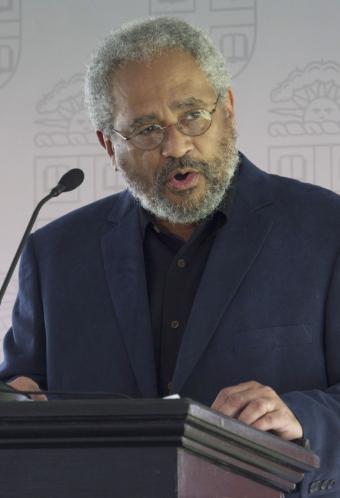President Paxson, distinguished guests, faculty, alumni and students, friends of Brown University — Good afternoon.
Anniversaries are peculiar moments. They are Janus-faced, looking to the future while simultaneously facing the past. So we are here today on our own 250th anniversary — an extraordinary achievement in the life of any institution. We are here to mark the dedication of a slave memorial, a remarkable memorial to mark an aspect of our origins — not a trivial or incidental aspect, but a foundational one: this University’s deep connection to the Atlantic slave trade and American slavery.
As we gather here to mark this dedication, there is contiguous to where we are gathered a dig in which a Brown undergraduate class — “Archaeology of College Hill” — is digging to find traces of the house of the first president of the University, James Manning (president from 1765-91). We know that President Manning had a slave, and there is a debate about whether or not he freed the slave. What is not debatable is that he accepted donations for the University from slave owners. This was not strange or unusual because at that time Rhode Island was the epicenter of the Atlantic slave trade, a major gateway for slaves into America and the Caribbean.
So here we are today — an anniversary, a dedication, a digging, all jostling up against each other. All in a tussle because at the core of this juxtaposition — dig, dedication, anniversary — is what story should we tell about our University — and most importantly, how should we frame the story? As I reflect upon this juxtaposition I am reminded of the conflicts between the Brown brothers, between John and Moses, as Moses becomes a abolitionist. But I am also reminded of the black abolitionist Frederick Douglass’s July 5, 1852, speech in Rochester, New York, “The Meaning of July Fourth for the Negro.”
For Douglass was speaking at a moment when racial slavery was still the order of the day in this country and on the occasion of the 76th anniversary of our nation. And in this context Douglass said, “I hear the mournful wail of millions, whose chains, heavy and grievous yesterday, are today rendered more intolerable by the jubilee shouts that reach them.” Should I forget, Douglass continued, “those bleeding children of sorrow this day?”
I am forcibly struck by this — Douglass by then is free; he is a famous orator, a well-known abolitionist. He is almost at the height of his powers, and yet he recalls, he remembers “the children of sorrow.” There is no doubt that in dedicating this slavery memorial we mark a moment, one which realizes a profound juncture in Brown’s history: where we are as a University, grappling with our past. Dr. Ruth Simmons made clear in announcing the Slavery and Justice Committee “this past will not go away.” It will not go away because it is a past that is troubled. It haunts us unless it is worked through — and worked through, to use an African-American idiom, by crossing over to the other side of the River Jordan. So today we dedicate and we reflect.
But should this dedication not be another beginning? A way to begin another journey, one which will take us to the banks of the river? Let me put it plainly: Do we not hear the sorrow of the children in Ferguson; of the men in our jails because of race; of the children who go to inadequate public schools; of the consequences of the structures of racism which are still alive? As we dedicate this memorial to the enslaved and their struggles to be free, do we applaud ourselves or do we think about the unfinished business in our country?
A memorial is not only a marker that creates pause, that makes us say, “That’s done.” A memorial is also about things to do, recognizing work done but beckoning us forward.
This memorial has chains which are open. Its last links are broken, but it is stretched upward. It calls upon us not only to wade in the water but to cross over to something else. That something else might look distant, might seem intangible, but it is that something else which will allow us to repair and recognize the benefits our University accrued from the trade in human flesh.
And what is that something else? To find it, we might focus on the broken chain link. One breaks a chain to be free. So what is this freedom we must search for? As we build “Brown with Distinction,” as we build “Brown in the World,” we might want to heed the sorrow of children, the cries of of those wounded by structural inequities and racism.
As we heed those sorrows and cries we might want to reflect that the business of freedom is as yet unfinished, that at each historic moment the ghost of James Manning’s slave will haunt us — and that to tackle that ghost we should be inspired by a memorial in which a broken chain opens toward the infinite possibilities of freedom. Today perhaps more than ever we live in a world where it might seem problematic to speak of these things, seem strange or out of sync. But the memorial calls us to face these matters and to speak of them. For not to speak is to close the broken chain link.
Thank you very much for allowing me to share my reflections on this historic day.
See also
Text of remarks by President Paxson
Text of remarks by Martin Puryear
The Slavery Memorial dedication

